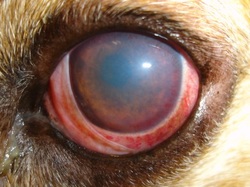
Glaucoma is common in certain dog breeds that are genetically predisposed, such as Samoyeds, Cocker Spaniels, Poodles, Chow Chows, and Siberian Huskies. Unfortunately, 40 percent of dogs affected by glaucoma will become blind in the affected eye within the first year, regardless of medical or surgical treatment.
Symptoms and Types
There are two main types of glaucoma: primary and secondary. Symptoms for sudden primary disease, due to the eye's inability to drain through the filtration angles of the eye, are as follows:
- High pressure within the eye
- Blinking of the eye
- The eyeball may recede back into the head
- Redness of the blood vessels in the whites of eyes
- Cloudy appearance at front of the eye
- Dilated pupil – or pupil does not respond to light
- Vision loss
Long-term, advanced disease:
- Enlargement of the eyeball (buphthalmos)
- Obvious loss of vision
- Advanced degeneration within the eye
Symptoms for secondary glaucoma, or glaucoma due to secondary eye infection(s), include:
- High pressure within the eye
- Redness of the blood vessels in the whites of eyes
- Cloudy appearance at front of the eye
- Inflammatory debris visible in the front of the eye
- Possible constriction of the pupil
- Possible sticking of the iris to either the cornea or the lens
- Possible that the edge of the iris circularly sticks to the lens
In addition, there may be:
- Headaches, with head pressing to relieve feelings of pressure in head
- Loss of appetite
- Change in attitude, less desire to play or interact
Causes
High pressure in the eye occurs when the normal outflow of fluid in the eye is impaired due to a primary eye disease such as the improper development of the eye's filtration angles, or secondary to other eye diseases such as primary lens luxation (slipping of the lens in the eye), inflammation of the tissues of the eye, eye tumor(s), or blood collection in the front of the eye from injury. In dogs, secondary glaucoma is more common than primary glaucoma.
Diagnosis
You will need to give a thorough history of your dog's health, onset of symptoms, as far as you have been able to tell, and possible incidents that might have preceded this condition, such as injuries to the eye (even those which you consider minor). During the physical examination, your veterinarian will test the pressure within your dog's eyes using a tonometer on the surface of the eye. If the disease began suddenly, your veterinarian will refer your dog to a veterinary ophthalmologist for a detailed examination of both eyes, including evaluation of the filtration angles by gonioscopy -- measuring the anterior of the eye. Pressure within the eye can measure as high as 45 to 65 mmHg, making this a very painful condition.
Electroretinography will be also performed by the veterinary ophthalmologist to determine if the eye will remain blind despite treatment. In secondary diseases, X-rays and an ultrasound may show abnormalities within the eye.
Often both eyes are affected, but not always. In cases where only one eye is affected, steps will be taken to protect the unaffected eye from developing a diseased condition.
Treatment
Your veterinarian will prescribe multiple drugs to lower the pressure within your dog's eye and to get it into the normal range as quickly as possible in an attempt to salvage vision. Often, a dog will have a long-term condition that has gone unnoticed or that has been misdiagnosed before the obvious symptoms of glaucoma have become present. In such cases, the optical nerve has been damaged beyond reparation and surgery may be indicated.
There are different treatments depending on the exact nature of the glaucoma. The fluid may be drained and the fluid producing cells altered to stop fluid buildup within the eye. This process, called cyclocryotherapy, uses cold temperatures to kill the cells that produce intraocular fluid. If found early, this procedure may slow down or stop further progression. However, in most long term cases the eye will have to be removed. The empty eye socket may be closed up permanently, or the eye cavity can be filled with an orb, to keep the ocular space filled.
Most dogs will adjust over time to the loss of their eye, especially as they may have been losing their vision over a period pf time. Talk to your veterinarian about ways in which you can help your dog to transition, and how you can help to make its home and outdoor life easier without its sight. In such cases, you will need to attend your dog when it is outdoors, as it will be more vulnerable to other animals.
Living and ManagementIf the condition has been caught early enough and your veterinarian is able to manage the condition, you will need to revisit your veterinarian regularly to have the pressure within the eye assessed and to monitor for drug interactions and make changes as necessary. Your veterinary ophthalmologist will examine the unaffected (or "good") eye to determine its risk of also developing glaucoma. Because more than 50 percent of dogs with primary glaucoma will develop complications in their unaffected eye within 8 months, preventative therapy should be done quickly.

 RSS Feed
RSS Feed
